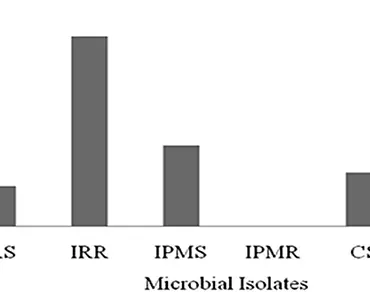Biochemical and molecular characterization of wheat-associated bacteria: implications for plant growth and disease resistance
*Article not assigned to an issue yet
Ummat-ul-Habib, Bano Asghari, Billah Motsim, Khan Irum, Khan Naeem
Research Articles | Published: 23 April, 2025
First Page: 0
Last Page: 0
Views: 1238
Keywords: Antifungal activity, Silver nanoparticles, Plant growth-promoting rhizobacteria, Wheat, Abscisic acid, Phosphate solubilization
Abstract
The study of plant-microbe interactions in the rhizosphere is crucial for advancing sustainable agricultural practices, particularly in managing plant diseases and enhancing plant resilience. The rhizosphere of infected plants harbors a diverse microbiota with unique characteristics that can influence plant health and physiology. This study presents a comparative evaluation of three Plant Growth-Promoting Rhizobacteria (PGPR) isolates, salicylic acid (SA), and silver nanoparticles (AgNPs) concerning their effects on wheat physiology. PGPR strains were isolated from the rhizosphere of wheat infected with rust (Bacillus cereus JN624926.1), powdery mildew (Bacillus spp. HM063033.1), and from the uninfected wheat rhizosphere (Burkholderia spp. NC 0159471). These isolates were characterized for their ability to utilize carbon and nitrogen sources, solubilize phosphate, produce bacteriocins, and synthesize abscisic acid (ABA) in culture. The effects of these isolates, applied as bioinoculants, were compared with SA and AgNP treatments, administered through seed soaking and foliar spraying. Leaves were harvested at the booting stage to assess physiological parameters. Among the isolates, IRS (Bacillus cereus) exhibited the highest antifungal activity against Helminthosporium sativum. Notably, isolates derived from infected wheat rhizospheres demonstrated enhanced P solubilization, bacteriocin production, and ABA synthesis. These isolates stimulated chlorophyll and carotenoid biosynthesis, induced proline accumulation, and enhanced enzymatic antioxidant activities, specifically superoxide dismutase (SOD) and peroxidase (POD). The interactions of AgNPs with IRS (Bacillus cereus) exhibited either synergistic or antagonistic effects depending on the physiological parameter analyzed and the wheat variety under study. This research underscores the significance of PGPR in plant disease management and their potential as eco-friendly bioinoculants. This study highlights the importance of PGPR in plant disease management and underscores their potential as sustainable, bio-based solutions for improving crop productivity.

References
Babalola O.O. (2010) Beneficial bacteria of agricultural importance. Biotechnol Lett 32:1559–1570
Homma Y et al (1989) Antibiosis as a mode of action for plant growth-promoting rhizobacteria. J Gen Plant Pathol 55:186–192
Huang W et al (2008) Salicylic acid and abiotic stress signaling. Plant Signal Behav 3:493–496
Khan N (2025) Decoding phytohormone signaling in plant stress physiology: insights, challenges, and future directions. Environ Experimental Bot, 106099
Kloepper JW et al (1980) Enhanced plant growth by siderophores produced by plant growth-promoting rhizobacteria. Nature 286:885–886
Martínez-Viveros O et al (2010) Mechanisms and applications of plant growth-promoting rhizobacteria. World J Microbiol Biotechnol 26:1517–1528
Mishra V, Kumar P (2009) Ecotoxicological impacts of nanoparticles on soil microbial community. Environ Sci Technol 43:6228–6234
O’Malley RC, Lynn DG (2000) Root exudates and rhizosphere signaling. Plant Physiol 124:541–548
Senaratna T et al (2000) Salicylic acid induces multiple stress tolerance in bean and tomato plants. Plant Growth Regul 30:157–161
Sindhu SS et al (1999) Antagonistic potential of fluorescent pseudomonads and control of root rot of Mungbean. Microbiol Res 154:213–220
Wu SC et al (2005) Effects of biofertilizer containing N-fixer, P and K solubilizers on maize growth. Geoderma 125:155–166
Hebbar KP, Davey MR, Dart PJ, Lynch JM (1998) Interactions between Burkholderia Cepacia and soilborne fungal pathogens of maize. FEMS Microbiol Lett 159(1):75–83
Holt JG, Krieg NR, Sneath PHA, Staley JT, Williams ST (1994) Bergey’s manual of determinative bacteriology, 9th edn. Williams & Wilkins, Baltimore
Kravchenko LV, Leonova LI, Tikhonovich IA (2002) The role of plant growth-promoting rhizobacteria in crop protection and biological disease control. Appl Biochem Microbiol 38(3):229–237
Mayak S, Tirosh T, Glick BR (2004) Plant growth-promoting bacteria that confer resistance to water stress in tomatoes and peppers. Plant Sci 166(2):525–530
Ramamoorthy V, Viswanathan R, Raghuchander T, Prakasam V, Samiyappan R (2001) Induction of systemic resistance by Pseudomonas fluorescens against Xanthomonas Campestris Pv. malvacearum in cotton. Phytopathology 91(9):820–829
Rashid M, Khalil S, Ayub N, Alam S, Latif F (2004) Organic acid production and phosphate solubilization by phosphate-solubilizing microorganisms under in vitro conditions. Pak J Biol Sci 7(2):187–196
Riley MA, Wertz JE (2002) Bacteriocin diversity: ecological and evolutionary perspectives. Biochimie 84(5–6):357–364
Tabacchioni S, Visca P, Chiarini L (1993) Burkholderia Cepacia complex as plant growth-promoting rhizobacteria: impact on crops and soilborne diseases. Plant Soil 151(2):257–266
Zehnder GW, Murphy JF, Sikora EJ, Kloepper JW (2001) Application of rhizobacteria for induced resistance. Eur J Plant Pathol 107(1):39–50
Kovacs N (1956) Identification of Pseudomonas pyocyanea by the oxidase reaction. Nature 178(4535):703–703
McFadden D (1980) Econometric models for probabilistic choice among products. J Bus 53(3):S13–S29
Teaumroong N, Boonkerd N (1998) Detection of Bradyrhizobium spp. and B. japonicum in Thailand by primer-based technology and direct DNA extraction. Plant Soil 204:127–134
Author Information
Department of Plant Sciences, Quaid-i-Azam University, Islamabad, Pakistan